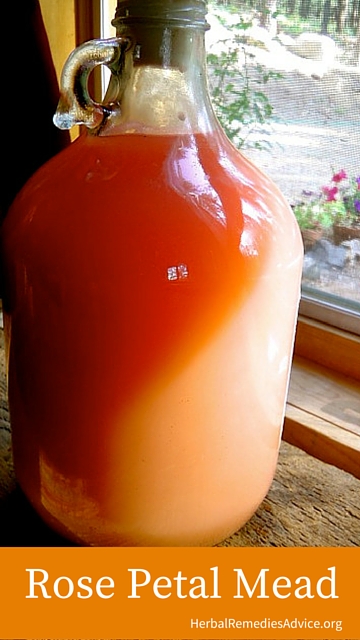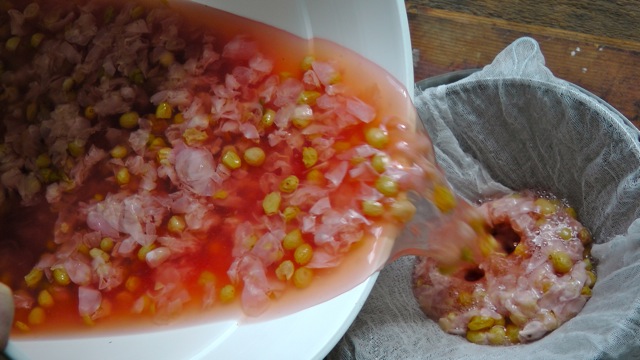Get weekly tips, recipes, and my Herbal Jumpstart e-course! Sign up for free today.

Wild Rose Petal Mead Recipe
Share this! |
|
This Wild Rose Petal Mead Recipe was part of the Cauldrons and Crockpots 'Wild Things Round Up'. Each month they choose a different wild food and participants write in with their scrumptious recipes. I highly recommend you check this out!
Harvesting wild roses is easily one of my favorite activities. I head out on a warm summer morning, smelling the roses before the briars come into view, and then quietly pluck the petals while bees buzz through the thickets. Then I head home with a basket of rose petals, practically swooning from the heady scent that then fills the kitchen.
Making medicine with roses leaves me with luxurious honeys and elixirs and other treats that money just can’t buy.
This year I wanted to try something new with our wild roses and mead seemed like a lovely endeavor. I basically adapted my dandelion flower wine recipe for wild rose petals. You can see a video of the dandelion flower wine here.
Wild Rose Petal Mead Recipe
Wild Rose Petal Mead Ingredients
- 10 oz of fresh rose petals (roughly 2 quarts)
- 1 pound raisins (chopped well)
- 2.6 pounds of honey
- 1/2 cup of lemon juice and zest
- 1/4 tsp yeast nutrient
- 1 handful sliced cherries (optional)
- Champagne yeast
- Cheesecloth
- One gallon jug and airlock
- Patience
Let's look at those in a little more details.
Wild Rose Petals
To make this batch I gathered both rose petals and rose buds. These roses were so intensely fragrant - I just wanted to curl up with them all day long. I
know someone out there is going to ask, "Can I use any roses, like the
ones in my front yard?" You CAN use any roses, but don't waste your time
with ones that don't smell and, obviously, be sure they haven't been
sprayed.
Raisins
Golden raisins have been treated with sulfur. If you want to avoid this
and get dark raisins they will work as well but they may make your wine
a darker color.
Lemon juice and zest
Be sure to get organic; you can also try oranges.
Yeast nutrient
I am often asked if you need this. I’ve always used it and have been
told it is necessary for making meads (aka honey wines) because the honey can slow the
fermentation process. You can easily find it at your
local wine supply store or online.
Cherries
Okay, you don’t really need the cherries. I added them because I really
wanted to make sure my mead turned out some shade of pink. Wild rose
mead would not be the same if it came out a dull brown.
Wild Rose Petal Mead Directions
If you’ve never made wine before, there are some tricks to it. The most important thing is that this needs to be a sterile (or at least very clean) process, otherwise you run the risk of making time-intensive vinegar.
Some wine makers use sulfite tablets to sterilize everything. We simply pour boiling water over everything that goes into our mixture: buckets, bowls, spoons, thermometer, etc. This isn’t technically sterile, but so far this has worked for us.
To begin making the mead, boil 1 gallon of water along with the honey for twenty minutes. Skim off any scum that accumulates on the surface.
While that is boiling, combine the rest of the ingredients, except the yeast, into a food-grade bucket.
Once the honey and water have boiled for 20 minutes, pour this liquid over all the ingredients in the food-grade bucket. Stir well with a clean spoon.
Cover this mixture with a cloth and let it cool until it reaches about 85 degrees F. Prepare the yeast as it is instructed on the package and then add that as well.
Now your mead is in the primary fermentation stage. Let it sit covered for 10 days, stirring it gently every day. I pour boiling water over a metal spoon each time I stir.
After ten days you can strain off the mead. I do this by using a cheesecloth-lined strainer, so I can really squeeze the juice out. Not super sterile but so far it’s worked!
The solid ingredients can be composted and the remaining liquid can be put into a carboy.
We use an old apple cider jug that just happens to fit an airlock (with a little prodding). If there is significant head space in your carboy you will want to add enough (sterilized water) to fill it up. We boil water, let it cool to room temperature, and then fill the carboy up.
This
is your second stage of fermentation. Let this sit for 60 days or so,
and then siphon it out into another gallon jug and affix that with an
airlock (this is called racking). Some people do this 1-3 times before
bottling. Honestly, we rarely do it all. I’ve heard that racking improves flavor and keeps the wine a pretty color. I have to say that I have the
most incredible-tasting St. John’s Wort Cherry Mead that was never racked and is an intense rose color.
I know that right now you are thinking, WOW, this is amazing! I can’t wait to taste my own wild rose petal mead. Unfortunately I do have some bad news for you.
Your mead will be ready in a year. I am not kidding. But I promise you that mead is going to be worth ten times its weight in gold. And if you get into the habit of making it every year, you can be sipping on your wild rose mead while you are brewing up your newest batch.

Rosalee is an herbalist and author of the bestselling book Alchemy of Herbs: Transform Everyday Ingredients Into Foods & Remedies That Healand co-author of the bestselling book Wild Remedies: How to Forage Healing Foods and Craft Your Own Herbal Medicine. She's a registered herbalist with the American Herbalist Guild and has taught thousands of students through her online courses. Read about how Rosalee went from having a terminal illness to being a bestselling author in her full story here.

